

DECEMBER 24, 2010
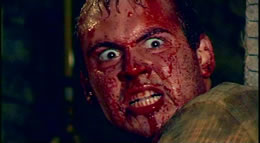 Those of you who caught the above-average 2007 homegrown horror offering Stash might have wondered what became of its director, Jacob Ennis. Well, the answer comes in the form of his second horror feature, 2010's outrageously gory Red River (no relation to the John Wayne film), which once again explores depraved doings among the financially deprived and morally bankrupt outside city limits. Here the grisly misdeeds revolve around Roland Thatcher, a God-fearing backwoods dweller who tends to prey on interlopers near his property. A bunch of newly-arrived kids and a nosy reporter offer the latest batch of potential victims, while the bulk of the film is devoted to the mayhem in his secret psycho hideaway featuring makeshift cages, corpses galore, and a slew of nastiness involving various limbs and fleshy appendages getting severed and often ground up to provide mulch to grow marijuana. Filled with nasty surprises and a pretty sick sense of humor, this one will definitely grab your attention and often feels like a homegrown spin on the wildly undervalued Wrong Turn 2. Unearthed's DVD contains a non-anamorphic letterboxed transfer (which is pretty much unheard of for any release these days, much less a recent title); as expected, it's on the soft side and not particularly detailed, which might be a blessing given the antics in the last half hour. Pretty much every step of the film's making was chronicled on video, which results in a ton of special features including "The River Runs Red" (a 35-minute overall making-of showing the director at work with the cast, some of whom sustained their fair share of bumps and bruises, interspersed with interview footage), the "Creating a Monster" fx featurette about the main villain, a "Video Blog: On Location" featurette," four minutes of chatty deleted scenes, and trailers for other Unearthed titles like Shock Festival, Stash, and A Feast of Flesh.
Those of you who caught the above-average 2007 homegrown horror offering Stash might have wondered what became of its director, Jacob Ennis. Well, the answer comes in the form of his second horror feature, 2010's outrageously gory Red River (no relation to the John Wayne film), which once again explores depraved doings among the financially deprived and morally bankrupt outside city limits. Here the grisly misdeeds revolve around Roland Thatcher, a God-fearing backwoods dweller who tends to prey on interlopers near his property. A bunch of newly-arrived kids and a nosy reporter offer the latest batch of potential victims, while the bulk of the film is devoted to the mayhem in his secret psycho hideaway featuring makeshift cages, corpses galore, and a slew of nastiness involving various limbs and fleshy appendages getting severed and often ground up to provide mulch to grow marijuana. Filled with nasty surprises and a pretty sick sense of humor, this one will definitely grab your attention and often feels like a homegrown spin on the wildly undervalued Wrong Turn 2. Unearthed's DVD contains a non-anamorphic letterboxed transfer (which is pretty much unheard of for any release these days, much less a recent title); as expected, it's on the soft side and not particularly detailed, which might be a blessing given the antics in the last half hour. Pretty much every step of the film's making was chronicled on video, which results in a ton of special features including "The River Runs Red" (a 35-minute overall making-of showing the director at work with the cast, some of whom sustained their fair share of bumps and bruises, interspersed with interview footage), the "Creating a Monster" fx featurette about the main villain, a "Video Blog: On Location" featurette," four minutes of chatty deleted scenes, and trailers for other Unearthed titles like Shock Festival, Stash, and A Feast of Flesh.
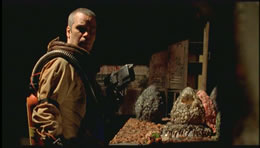 Imagine a very claustrophobic, very low budget version of the '80s Italian cult favorite Contamination mixed with Office Space set on Mars, and that should give you a pretty good idea of what to expect from Interplanetary, a hilariously offbeat and often wonderful little sci-fi offering from 2008. Chance Shirley (Hide and Creep) helms this tale about some settlers on Mars who have basically devolved into a corporate-induced hell. The recent discovery of a fossil in a nearby cavern perks up their lives a bit, but things start to get out of control when strangers from a nearby base show up in a homicidal mood, an alien monster pops by for a bloody visit, and oh yeah, there's these funky slimy egg things lying around... Filled with great deadpan comedy and some creative visual flourishes, this DIY underdog from the Alabama filmmaker and cast is probably the world's only Southern-fried outer space alien gore comedy, but by God, it's one well worth checking out. The John Carpenter influence is obvious here (all the way from Dark Star to Ghosts of Mars), but this one's way too original and well written to write off as any kind of imitation. I dug it. The Shock-o-Rama DVD (which features some arty cover art that looks more like something out of Moon) features an anamorphic transfer that looks as good as possible given the deliberately grainy, cheap appearance of the feature itself, and Shirley chimes in with a lively and intelligent commentary track. Check it out.
Imagine a very claustrophobic, very low budget version of the '80s Italian cult favorite Contamination mixed with Office Space set on Mars, and that should give you a pretty good idea of what to expect from Interplanetary, a hilariously offbeat and often wonderful little sci-fi offering from 2008. Chance Shirley (Hide and Creep) helms this tale about some settlers on Mars who have basically devolved into a corporate-induced hell. The recent discovery of a fossil in a nearby cavern perks up their lives a bit, but things start to get out of control when strangers from a nearby base show up in a homicidal mood, an alien monster pops by for a bloody visit, and oh yeah, there's these funky slimy egg things lying around... Filled with great deadpan comedy and some creative visual flourishes, this DIY underdog from the Alabama filmmaker and cast is probably the world's only Southern-fried outer space alien gore comedy, but by God, it's one well worth checking out. The John Carpenter influence is obvious here (all the way from Dark Star to Ghosts of Mars), but this one's way too original and well written to write off as any kind of imitation. I dug it. The Shock-o-Rama DVD (which features some arty cover art that looks more like something out of Moon) features an anamorphic transfer that looks as good as possible given the deliberately grainy, cheap appearance of the feature itself, and Shirley chimes in with a lively and intelligent commentary track. Check it out.
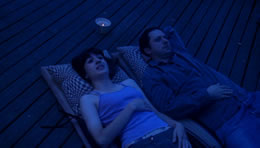 A horror film only in the loosest sense, 2010's Stiff sounds on paper like a stage version of Nekromantik but comes off quite differently on film. It's basically a two character drama in which suicide hotline operator Lorri (Lulu Benton) develops a bond with one of her more frequent callers, Troy (Bill Scott), and offers to "do something I'm not supposed to do"-- give out her personal number. They eventually agree to meet in person (including a trip to his apartment where he keeps a noose hanging from the ceiling) and come to a unique, mutually fulfilling agreement: she'll help him commit suicide if she can have her way with his dead body afterwards. Of course, the road to this outcome has a few speed bumps along the way, especially when Troy winds up falling for her and starts to question his resolve. Both actors are definitely up to the task here and aren't afriad to expose themselves emotionally or physically, and while the direction by Mike McKown and Jim Towns stumbles a bit with some amateurish montages and some uncertainty with camera placement, they do an excellent job of keeping the mood and dramatic focus in check all the way to the little twist ending. If Hal Hartley made a movie about necrophilia, there's a good chance it might come out looking something like this. Cinema Epoch's DVD features a pleasing anamorphic transfer, a making-of featurette comprised mainly of interviews with the filmmakers and two cast members, a trailer, a more downbeat alternate ending, a teaser and trailer, and a thoughtful audio commentary with the actors, directors and assistant camera and sound man Christopher Nickelson. And you really won't believe how much this one actually cost.
A horror film only in the loosest sense, 2010's Stiff sounds on paper like a stage version of Nekromantik but comes off quite differently on film. It's basically a two character drama in which suicide hotline operator Lorri (Lulu Benton) develops a bond with one of her more frequent callers, Troy (Bill Scott), and offers to "do something I'm not supposed to do"-- give out her personal number. They eventually agree to meet in person (including a trip to his apartment where he keeps a noose hanging from the ceiling) and come to a unique, mutually fulfilling agreement: she'll help him commit suicide if she can have her way with his dead body afterwards. Of course, the road to this outcome has a few speed bumps along the way, especially when Troy winds up falling for her and starts to question his resolve. Both actors are definitely up to the task here and aren't afriad to expose themselves emotionally or physically, and while the direction by Mike McKown and Jim Towns stumbles a bit with some amateurish montages and some uncertainty with camera placement, they do an excellent job of keeping the mood and dramatic focus in check all the way to the little twist ending. If Hal Hartley made a movie about necrophilia, there's a good chance it might come out looking something like this. Cinema Epoch's DVD features a pleasing anamorphic transfer, a making-of featurette comprised mainly of interviews with the filmmakers and two cast members, a trailer, a more downbeat alternate ending, a teaser and trailer, and a thoughtful audio commentary with the actors, directors and assistant camera and sound man Christopher Nickelson. And you really won't believe how much this one actually cost.
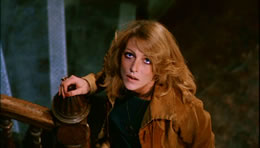 The legendary Roger Corman didn't actually have much to do with the 1978 haunted house offering The Evil apart from writing a check and releasing it under the banner of New World Pictures, but if it takes Shout Factory's Corman banner to get this puppy back in circulation, that's fine with me. A longtime cable TV favorite back in the early '80s, this flawed but enjoyable little spooker feels a bit like a Night Gallery episode hauled out to feature length. That might have something to do with the presence here of that show's most frequent guest star, the gorgeous Joanna Pettet, as Caroline Arnold, a shrink who decides to stake out a site for a new therapy location at an old house, a plan also enabled by her spouse and fellow doctor C.J. Arnold (a bearded Richard Crenna) and a bug-eyed science professor (Andrew Prine). However, once the group gets in session, weird events start happening, beginning with Caroline seeing a translucent white apparition and quickly escalating into outlandish violent deaths. An interesting if not entirely successful attempt to graft the template of The Legend of Hell House onto the touchy-feely psych-pop craze of the late '70s (which was handled most successfully in the same year's remake of Invasion of the Body Snatchers), this film is more accomplished and effective than its dismissive critical reputation might indicate but definitely suffers from a truly bizarre, out of left field finale that will prove to be a major dealbreaker for some viewers. (To avoid excessive spoilers, let's just say it involves a hairy Victor Buono in a terrifying white suit.) Paired up with this film on Shout Factory's DVD is a much later VHS favorite, Twice Dead, presumably included because it's also a sorta-ghost story, too. Here we have a couple of naive college students, Scott (Mirror Mirror's Tom Bresnahan) and Robin (Night of the Creeps' Jill Whitlow), who have two big problems when they inherit a creepy house in a bad Los Angeles neighborhood: threatening gang members and the spirit of an actor who used to live there. How the two plot strands intersect is best left unexplained for new viewers, but this film definitely doesn't take the obvious way out in its second half. While the street punks are a typical '80s bunch of fashion victims who could've stepped out of Death Wish III, this is a diverting time waster with an able cast (including some surprising turns by Todd Bridges and Meridian T&A queen Charlie Spradling) and a crackerjack finale. It's not a neglected masterpiece by any means, but considering how rare solid ghost movies were during the late slasher era, it's a worthwhile entry for horror fans. Both films feature much-needed anamorphic upgrades that blow away the lousy previous versions (both were out as full frame DVDs taken from ancient one-inch masters); some print damage pops up here and there, but it's nothing remotely serious. The first film comes with a theatrical trailer, TV spot ,and a commendable audio commentary featuring director Gus Trikonis (who also helmed the drive-in favorite The Swinging Barmaids), cinematographer Mario DiLeo, and writer Donald Thompson (all of whom remember the production well and shed some light on that odd, tacked-on ending), while Breslahan and director Bert Dragin (whose only other film was the bizarre Summer Camp Nightmare) join forces for the second feature and offer plenty of anecdotes about how the project came together. The charming Whitlow (who should have been a much bigger scream queen) appears separately for a 12-minute interview; the features can also be watched as a Roger Corman Grindhouse Experience back to back along with trailers for other Corman titles in the collection like Galaxy of Terror and Not of This Earth.
The legendary Roger Corman didn't actually have much to do with the 1978 haunted house offering The Evil apart from writing a check and releasing it under the banner of New World Pictures, but if it takes Shout Factory's Corman banner to get this puppy back in circulation, that's fine with me. A longtime cable TV favorite back in the early '80s, this flawed but enjoyable little spooker feels a bit like a Night Gallery episode hauled out to feature length. That might have something to do with the presence here of that show's most frequent guest star, the gorgeous Joanna Pettet, as Caroline Arnold, a shrink who decides to stake out a site for a new therapy location at an old house, a plan also enabled by her spouse and fellow doctor C.J. Arnold (a bearded Richard Crenna) and a bug-eyed science professor (Andrew Prine). However, once the group gets in session, weird events start happening, beginning with Caroline seeing a translucent white apparition and quickly escalating into outlandish violent deaths. An interesting if not entirely successful attempt to graft the template of The Legend of Hell House onto the touchy-feely psych-pop craze of the late '70s (which was handled most successfully in the same year's remake of Invasion of the Body Snatchers), this film is more accomplished and effective than its dismissive critical reputation might indicate but definitely suffers from a truly bizarre, out of left field finale that will prove to be a major dealbreaker for some viewers. (To avoid excessive spoilers, let's just say it involves a hairy Victor Buono in a terrifying white suit.) Paired up with this film on Shout Factory's DVD is a much later VHS favorite, Twice Dead, presumably included because it's also a sorta-ghost story, too. Here we have a couple of naive college students, Scott (Mirror Mirror's Tom Bresnahan) and Robin (Night of the Creeps' Jill Whitlow), who have two big problems when they inherit a creepy house in a bad Los Angeles neighborhood: threatening gang members and the spirit of an actor who used to live there. How the two plot strands intersect is best left unexplained for new viewers, but this film definitely doesn't take the obvious way out in its second half. While the street punks are a typical '80s bunch of fashion victims who could've stepped out of Death Wish III, this is a diverting time waster with an able cast (including some surprising turns by Todd Bridges and Meridian T&A queen Charlie Spradling) and a crackerjack finale. It's not a neglected masterpiece by any means, but considering how rare solid ghost movies were during the late slasher era, it's a worthwhile entry for horror fans. Both films feature much-needed anamorphic upgrades that blow away the lousy previous versions (both were out as full frame DVDs taken from ancient one-inch masters); some print damage pops up here and there, but it's nothing remotely serious. The first film comes with a theatrical trailer, TV spot ,and a commendable audio commentary featuring director Gus Trikonis (who also helmed the drive-in favorite The Swinging Barmaids), cinematographer Mario DiLeo, and writer Donald Thompson (all of whom remember the production well and shed some light on that odd, tacked-on ending), while Breslahan and director Bert Dragin (whose only other film was the bizarre Summer Camp Nightmare) join forces for the second feature and offer plenty of anecdotes about how the project came together. The charming Whitlow (who should have been a much bigger scream queen) appears separately for a 12-minute interview; the features can also be watched as a Roger Corman Grindhouse Experience back to back along with trailers for other Corman titles in the collection like Galaxy of Terror and Not of This Earth.
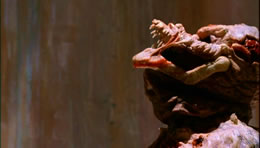 Speaking of '80s Corman films, another one revived from the VHS oblivion pile by Shout Factory is the surprisingly swift and efficient The Terror Within, a sci-fi/horror hybrid from 1989 with an obvious debt to a certain franchise kicked off by Ridley Scott in '79 with a little dose of The Andromeda Strain for good measure. When most of the human population is wiped out by a chemically-engineered mishap, some surviving scientists (led by George Kennedy!) scramble against the clock with limited means to come up with a foolproof means to innoculate the rest of human race. When a pregnant woman turns up at their underground desert facility, they're optimistic -- until her baby turns out to be a monstrous spawn that gets loose and begins picking everyone off one by one. Can heroic scientists Andrew Stevens and Terri Treas find a way to knock off the beast before it rips through the entire cast? Well, given that Stevens went on to star in and direct The Terror Within II a couple of years later (with his mom Stella as co-star!), you only get one guess. Made when Corman's company was simply known as Concorde Pictures, this one definitely betrays its extremely low budget throughout but manages to deliver the goods thanks to an effective "gargoyle" creature design by Dean Jones (who went on to do Mike Mendez's underrated The Convent) and no-nonsense direction by Theirry Notz, who unfortunately left the genre after this and the far inferior Watchers II. Paired up on Shout Factory's DVD release is another grisly sci-fi outing, 1991's Dead Space, a more blatant Alien copy that pads its 80-minute running time with 90% filler and 10% monster mayhem involving a creature with, shall we say, extremely limited mobility. Marc Singer stars along with plenty of familiar footage from past Corman space outings like Battle Beyond the Stars (or, if you will, the much more similar Forbidden World, which opens almost identically). See, there are these scientists in space at a research facility called Phaebon, and they're trying to fight off a nasty virus called Delta 5. When they hit a genetically-engineered snag, Singer shows up to help just as a monstrous offshoot of their experiments gets loose on the ship and very, very slowly hunts them all down. The big selling point here is a very young Bryan Cranston before he went on to TV glory with Malcolm in the Middle and especially the great Breaking Bad; he doesn't really get a lot to do here, but then again, neither does anyone else. Die-hard fans of this lesser stretch from the Concorde Pictures, but for entertainment value, this is pretty slim pickings. The first feature gets a solid new anamorphic transfer and trailer, while its companion film is presented full frame from what is probably Corman's only master and comes with an audio commentary track with Fred Gallo that's more entertaining than the film itself. Once again you can play it all from the theater lobby menu with a grindhouse-style option with back-to-back movies and lots of bonus trailers.
Speaking of '80s Corman films, another one revived from the VHS oblivion pile by Shout Factory is the surprisingly swift and efficient The Terror Within, a sci-fi/horror hybrid from 1989 with an obvious debt to a certain franchise kicked off by Ridley Scott in '79 with a little dose of The Andromeda Strain for good measure. When most of the human population is wiped out by a chemically-engineered mishap, some surviving scientists (led by George Kennedy!) scramble against the clock with limited means to come up with a foolproof means to innoculate the rest of human race. When a pregnant woman turns up at their underground desert facility, they're optimistic -- until her baby turns out to be a monstrous spawn that gets loose and begins picking everyone off one by one. Can heroic scientists Andrew Stevens and Terri Treas find a way to knock off the beast before it rips through the entire cast? Well, given that Stevens went on to star in and direct The Terror Within II a couple of years later (with his mom Stella as co-star!), you only get one guess. Made when Corman's company was simply known as Concorde Pictures, this one definitely betrays its extremely low budget throughout but manages to deliver the goods thanks to an effective "gargoyle" creature design by Dean Jones (who went on to do Mike Mendez's underrated The Convent) and no-nonsense direction by Theirry Notz, who unfortunately left the genre after this and the far inferior Watchers II. Paired up on Shout Factory's DVD release is another grisly sci-fi outing, 1991's Dead Space, a more blatant Alien copy that pads its 80-minute running time with 90% filler and 10% monster mayhem involving a creature with, shall we say, extremely limited mobility. Marc Singer stars along with plenty of familiar footage from past Corman space outings like Battle Beyond the Stars (or, if you will, the much more similar Forbidden World, which opens almost identically). See, there are these scientists in space at a research facility called Phaebon, and they're trying to fight off a nasty virus called Delta 5. When they hit a genetically-engineered snag, Singer shows up to help just as a monstrous offshoot of their experiments gets loose on the ship and very, very slowly hunts them all down. The big selling point here is a very young Bryan Cranston before he went on to TV glory with Malcolm in the Middle and especially the great Breaking Bad; he doesn't really get a lot to do here, but then again, neither does anyone else. Die-hard fans of this lesser stretch from the Concorde Pictures, but for entertainment value, this is pretty slim pickings. The first feature gets a solid new anamorphic transfer and trailer, while its companion film is presented full frame from what is probably Corman's only master and comes with an audio commentary track with Fred Gallo that's more entertaining than the film itself. Once again you can play it all from the theater lobby menu with a grindhouse-style option with back-to-back movies and lots of bonus trailers.
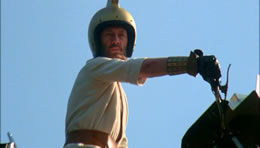 In the future, there will be... motorcycles. Much more consistent is our next Corman/Shout Factory pairing, a real godsend to fans of trashy post-nuke thrills, kicking off with 1978's Deathsport, which reunites Corman with Death Race 2000 star David Carradine. More interestingly, it's co-directed by Alan Arkush in between the more famous Hollywood Boulevard and Rock 'n' Roll High School. On top of that, it's got a prime drive-in supporting cast including the late Claudia Jennings (Gator Bait) in her last film (complete with copious nudity, of course) and the always solid Richard Lynch and Jesse Vint. With credentials like that, most viewers won't mind that this is basically a retread of Carradine's previous hit (it's even promoted sometimes as a sequel) in which he once again plays a futuristic cyborg racer involved in a deadly race staged for society's amusement. Here he's Kaz Oshay, a desert ranger forced to compete on a "destructocycle" against the formidable Ankar (Lynch). Basically that's an excuse for lots of loud choppers, skin, laser guns, and violence, all delivered with the usual budget-conscious New World panache with a memorable head-sling swordfight finale. Though both leads are no longer with us, Arkush pops up for a new audio commentary track on the DVD along with editor Larry Brock, and it's one of the best of all the Corman releases. They're candid and often hilarious as they rattle off the history of the film, including its obvious inspirations and the recreational means the cast used to entertain themselves out in the desert. The new anamorphic transfer is stitched together from a great-looking print used for TV and snippets from a splicier R-rated print; it's not 100% consistent but definitely better than the previous, long-discontinued New Concorde DVD release, which just looked ghastly. Its co-feature here is another futuristic desert outing (this time shot in New Zealand), 1982's Battletruck, far better known to VHS junkies as Warlords of the Twenty-First Century. The Warriors and Xanadu star Michael Beck (who also appeared in the much more expensive and oddly similar Megaforce the same year) headlines as Hunter, your typical nice guy stuck in a bad situation -- namely a gas-deprived world that's barely limping along after World War III. When a bunch of thugs led by the evil Straker (James Wainwright) decide to attack a peaceful settlement nearby, Hunter has no choice but to hop on his motorcycle and go all Billy Jack on their butts. Once again the supporting cast here is pretty startling, including a range of players like The Hand's Annie McEnroe, The Quiet Earth's Bruno Lawrence (who quicky went on to much more prestigious parts), and even Cheers' John Ratzenberger before he went on to Pixar Films and Republican Party cheerleading. Unfortunately the PG rating means this never comes close to the bone-breaking force of competing films like the Mad Max cycle, but if you like seeing big loud vehicles roaring around a post-apocalyptic playground, this should fit the bill. A pretty dated full frame master is used here (good luck finding a print), and it's passable enough but nothing special if you don't mind a certain VHS-era aesthetic. Once again you get a commentary track, with director Harley Cokliss (Malone) and moderator Jonathan Rigby chatting about the film's creation, the Megaforce connection, and how to make a post-nuke society on the budget of a dinner party. Still galleries for both films, Deathsport trailers and TV spot, and bonus trailers round out a package that gives you plenty of entertainment value for one little disc.
In the future, there will be... motorcycles. Much more consistent is our next Corman/Shout Factory pairing, a real godsend to fans of trashy post-nuke thrills, kicking off with 1978's Deathsport, which reunites Corman with Death Race 2000 star David Carradine. More interestingly, it's co-directed by Alan Arkush in between the more famous Hollywood Boulevard and Rock 'n' Roll High School. On top of that, it's got a prime drive-in supporting cast including the late Claudia Jennings (Gator Bait) in her last film (complete with copious nudity, of course) and the always solid Richard Lynch and Jesse Vint. With credentials like that, most viewers won't mind that this is basically a retread of Carradine's previous hit (it's even promoted sometimes as a sequel) in which he once again plays a futuristic cyborg racer involved in a deadly race staged for society's amusement. Here he's Kaz Oshay, a desert ranger forced to compete on a "destructocycle" against the formidable Ankar (Lynch). Basically that's an excuse for lots of loud choppers, skin, laser guns, and violence, all delivered with the usual budget-conscious New World panache with a memorable head-sling swordfight finale. Though both leads are no longer with us, Arkush pops up for a new audio commentary track on the DVD along with editor Larry Brock, and it's one of the best of all the Corman releases. They're candid and often hilarious as they rattle off the history of the film, including its obvious inspirations and the recreational means the cast used to entertain themselves out in the desert. The new anamorphic transfer is stitched together from a great-looking print used for TV and snippets from a splicier R-rated print; it's not 100% consistent but definitely better than the previous, long-discontinued New Concorde DVD release, which just looked ghastly. Its co-feature here is another futuristic desert outing (this time shot in New Zealand), 1982's Battletruck, far better known to VHS junkies as Warlords of the Twenty-First Century. The Warriors and Xanadu star Michael Beck (who also appeared in the much more expensive and oddly similar Megaforce the same year) headlines as Hunter, your typical nice guy stuck in a bad situation -- namely a gas-deprived world that's barely limping along after World War III. When a bunch of thugs led by the evil Straker (James Wainwright) decide to attack a peaceful settlement nearby, Hunter has no choice but to hop on his motorcycle and go all Billy Jack on their butts. Once again the supporting cast here is pretty startling, including a range of players like The Hand's Annie McEnroe, The Quiet Earth's Bruno Lawrence (who quicky went on to much more prestigious parts), and even Cheers' John Ratzenberger before he went on to Pixar Films and Republican Party cheerleading. Unfortunately the PG rating means this never comes close to the bone-breaking force of competing films like the Mad Max cycle, but if you like seeing big loud vehicles roaring around a post-apocalyptic playground, this should fit the bill. A pretty dated full frame master is used here (good luck finding a print), and it's passable enough but nothing special if you don't mind a certain VHS-era aesthetic. Once again you get a commentary track, with director Harley Cokliss (Malone) and moderator Jonathan Rigby chatting about the film's creation, the Megaforce connection, and how to make a post-nuke society on the budget of a dinner party. Still galleries for both films, Deathsport trailers and TV spot, and bonus trailers round out a package that gives you plenty of entertainment value for one little disc.
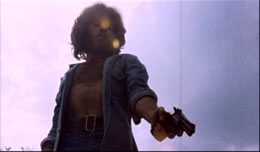 A terrific soundtrack in search of a film, 1978's Death of a Snowman (also released as Soul Patrol and Black Trash) is a mostly forgotten South African crime drama with a wildly overqualified cast. Ken Gampu (The Gods Must Be Crazy) stars as Steve Chaka, a journalist in Johannesburg investigating a bunch of violent vigilante killings by a militant black group. Then there's Snowman himself, a shaggy-haired hitman who might be tied in to the mayhem (or maybe not, since the film seems to forget about him for long stretches). Steve winds up teaming with a police lieutenant (Nigel Davenport, hot off of Phase IV and the '77 version of The Island of Dr. Moreau) and soon finds out that the definition of morality is very fuzzy indeed, especially during a violent showdown after finding out the true nature of his foes. Basically a slower rip-off of the sadly forgotten Report to the Commissioner, the film boasts a terrific funk score and some nice soul songs that propel the action along even when the film itself seems to be swerving all over the place with no direction in sight. The script and camerawork are as haphazard as can be, and for some reason all the dialogue appears to be redubbed in post with the absolute minimum amount of emotion required. Some okay bursts of action here and there will keep you awake, but don't expect a lost drive-in classic by any means. Synapse's DVD does what it can with the ragged and unimpressive film materials at hand; this looks like a well-loved '70s print by all appearances, and while it's fine, don't expect it to come close to their usual standards of excellence. A theatrical trailer is the only extra.
A terrific soundtrack in search of a film, 1978's Death of a Snowman (also released as Soul Patrol and Black Trash) is a mostly forgotten South African crime drama with a wildly overqualified cast. Ken Gampu (The Gods Must Be Crazy) stars as Steve Chaka, a journalist in Johannesburg investigating a bunch of violent vigilante killings by a militant black group. Then there's Snowman himself, a shaggy-haired hitman who might be tied in to the mayhem (or maybe not, since the film seems to forget about him for long stretches). Steve winds up teaming with a police lieutenant (Nigel Davenport, hot off of Phase IV and the '77 version of The Island of Dr. Moreau) and soon finds out that the definition of morality is very fuzzy indeed, especially during a violent showdown after finding out the true nature of his foes. Basically a slower rip-off of the sadly forgotten Report to the Commissioner, the film boasts a terrific funk score and some nice soul songs that propel the action along even when the film itself seems to be swerving all over the place with no direction in sight. The script and camerawork are as haphazard as can be, and for some reason all the dialogue appears to be redubbed in post with the absolute minimum amount of emotion required. Some okay bursts of action here and there will keep you awake, but don't expect a lost drive-in classic by any means. Synapse's DVD does what it can with the ragged and unimpressive film materials at hand; this looks like a well-loved '70s print by all appearances, and while it's fine, don't expect it to come close to their usual standards of excellence. A theatrical trailer is the only extra.
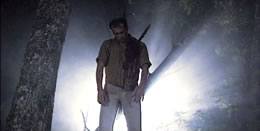 A more representative example of Synapse's gift for unearthing peculiar delights is 2006's Resonnances, a super-cheap French monster mash that begins in the 17th century as a young woman (in what looks like her nightgown) sees a meteor crash in the middle of the woods and is hunted down by a subterranean menace. Flash forward to the present day as six friends out for a weekend getaway in the mountains run afoul of a menacing hitchhiker and wind up tearing off into the fog where an accident puts them in the path of the same ground-dwelling tentacled terror. Oh yeah, and there's a ghostly woman in white from an urban legend that might figure in all of it, too, especially since she's the one who causes the wreck. Shot on standard def video (and matted in-camera, which means the DVD is 4:3 letterbox), this is hardly the most technically accomplished film on the planet; in fact, some night scenes are so poorly shot, you can barely tell what's going on. If you can get over that hurdle, though, there's plenty of fun to be had thanks to the rousing monster scenes, some nifty creature effects, and a truly unpredictable, bizarre plotline that skips and darts in a few novel directions. The last shot is especially cool, though you'll probably see it coming. Synapse's disc does what it can given the cheapo nature of the original source and features optional English subtitles for the French dialogue. The only extras is the theatrical trailer.
A more representative example of Synapse's gift for unearthing peculiar delights is 2006's Resonnances, a super-cheap French monster mash that begins in the 17th century as a young woman (in what looks like her nightgown) sees a meteor crash in the middle of the woods and is hunted down by a subterranean menace. Flash forward to the present day as six friends out for a weekend getaway in the mountains run afoul of a menacing hitchhiker and wind up tearing off into the fog where an accident puts them in the path of the same ground-dwelling tentacled terror. Oh yeah, and there's a ghostly woman in white from an urban legend that might figure in all of it, too, especially since she's the one who causes the wreck. Shot on standard def video (and matted in-camera, which means the DVD is 4:3 letterbox), this is hardly the most technically accomplished film on the planet; in fact, some night scenes are so poorly shot, you can barely tell what's going on. If you can get over that hurdle, though, there's plenty of fun to be had thanks to the rousing monster scenes, some nifty creature effects, and a truly unpredictable, bizarre plotline that skips and darts in a few novel directions. The last shot is especially cool, though you'll probably see it coming. Synapse's disc does what it can given the cheapo nature of the original source and features optional English subtitles for the French dialogue. The only extras is the theatrical trailer.
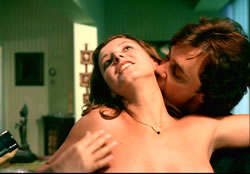 DVD label Impulse has managed to unearth some real gems from the incredible Brazilian "pornochanchada" era, an amped-up fusion of sex and stylized mayhem that resulted in films like The Chick's Ability and Violence and Flesh. Despite its title, 1981's Porno isn't hardcore smut; instead it's a lunatic three-part anthology film that starts off like a standard softcore cable offering and then veers into territory you have to see to believe. In story one, lesbian Bia (genre regular Maristella Moreno) keeps failing school so she can stick around seducing her younger virginal classmates, and now her latest target (Patricia Scalvi, star of the nutty and much more explicit A Noite de Taras) doesn't stand a chance when a study session turns naughty thanks to a strategically applied book of erotica. Story two is pretty much a showcase for star and director David Cardoso, easily the era's busiest and most exhibitionistic male lead, who built an entire feature around himself the next year with the wild As Seis Mulheres de Adão. Here he's a playboy named Romano who gets off on anticipation so much he decides to tease his newest possible conquest (Matilde Mastrangi) to the breaking point via mutual shower spying and role playing involving a bit of religious kink. However, it's the third story that really pays off as a guy named Arthur (Arthur Roveder, who later teamed up with Scalvi for the awesome, little-seen A Reencarnação do Sexo) who's driven nuts by the fact that his blind lover (Zélia Diniz) can somehow see what he's doing only in the house's many mirrors. He tries to block her vision by obscuring all the mirrors and even using a handy grasshopper as a sexual aid, but everything seems to backfire on him until the unexpected, surprisingly bloody climax. As with the previous two titles, the full frame transfer appears to be accurately framed and features a colorful, pleasing transfer (with slight windowboxing) as well as optional English subtitles for the Portuguese dialogue, though given the plentiful skin on display, you might not notice anyone speaking half the time.
DVD label Impulse has managed to unearth some real gems from the incredible Brazilian "pornochanchada" era, an amped-up fusion of sex and stylized mayhem that resulted in films like The Chick's Ability and Violence and Flesh. Despite its title, 1981's Porno isn't hardcore smut; instead it's a lunatic three-part anthology film that starts off like a standard softcore cable offering and then veers into territory you have to see to believe. In story one, lesbian Bia (genre regular Maristella Moreno) keeps failing school so she can stick around seducing her younger virginal classmates, and now her latest target (Patricia Scalvi, star of the nutty and much more explicit A Noite de Taras) doesn't stand a chance when a study session turns naughty thanks to a strategically applied book of erotica. Story two is pretty much a showcase for star and director David Cardoso, easily the era's busiest and most exhibitionistic male lead, who built an entire feature around himself the next year with the wild As Seis Mulheres de Adão. Here he's a playboy named Romano who gets off on anticipation so much he decides to tease his newest possible conquest (Matilde Mastrangi) to the breaking point via mutual shower spying and role playing involving a bit of religious kink. However, it's the third story that really pays off as a guy named Arthur (Arthur Roveder, who later teamed up with Scalvi for the awesome, little-seen A Reencarnação do Sexo) who's driven nuts by the fact that his blind lover (Zélia Diniz) can somehow see what he's doing only in the house's many mirrors. He tries to block her vision by obscuring all the mirrors and even using a handy grasshopper as a sexual aid, but everything seems to backfire on him until the unexpected, surprisingly bloody climax. As with the previous two titles, the full frame transfer appears to be accurately framed and features a colorful, pleasing transfer (with slight windowboxing) as well as optional English subtitles for the Portuguese dialogue, though given the plentiful skin on display, you might not notice anyone speaking half the time.
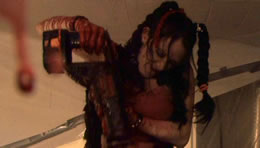 One of the more unlikely cult figures to pop up on the horror scene in the past decade is Chainsaw Sally, the brainchild of actress April Monique Burril and director JimmyO Burrill (Silver Scream). First seen headlining a 2004 feature film presented by Herschell Gordon Lewis, Sally's a seemingly timid part-time librarian caring for her little brother after their parents' violent death. When anyone upsets her sense of personal morality, Sally unleashes gory and often hilarious retribution. That's basically the same setup that fuels season one of The Chainsaw Sally Show, available in its entirety from Troma as a two-disc set and once again presented under the H.G. Lewis banner. Shot on DV, the show introduces a slew of guest stars and subplots accompanied by a hefty interactive online presence. That makes sense as this was originally a web series, with Azman Toy taking over as her invalid sibling, Ruby. Basically each vignette follows Sally on a murderous rampage, with the police sometimes trying and failing to take her down as she turns the local residents and visitors into mulch. An interesting anti-hero with her own personal code worthy of Dexter, Sally's a charismatic character whose continuing adventures should be enjoyable to watch. Horror vet Debbie Rochon even pops up for the DVD's biggest extra, the "very special bonus movie" Grindhog Day, in which our anti-heroes face off against a slew of film students. The whole enterprise is basically a sexed-up, gore-sprayed take-off of American sticoms, of course, and Troma's release treats it right with a bunch of extras including a making-of featurette ("21 Weekends in Porterville"), an "Anatomy of a Murder" FX short, a theme song music video, a bonus Sally short called "Can You Hear Me Now?," a Sally image gallery, a season two sneak peek, and of course, the usual Troma extras including a Lloyd Kaufman intro. Lots of morally questionable fun, especially if you like your twisted horror in tiny, bite-sized chunks.
One of the more unlikely cult figures to pop up on the horror scene in the past decade is Chainsaw Sally, the brainchild of actress April Monique Burril and director JimmyO Burrill (Silver Scream). First seen headlining a 2004 feature film presented by Herschell Gordon Lewis, Sally's a seemingly timid part-time librarian caring for her little brother after their parents' violent death. When anyone upsets her sense of personal morality, Sally unleashes gory and often hilarious retribution. That's basically the same setup that fuels season one of The Chainsaw Sally Show, available in its entirety from Troma as a two-disc set and once again presented under the H.G. Lewis banner. Shot on DV, the show introduces a slew of guest stars and subplots accompanied by a hefty interactive online presence. That makes sense as this was originally a web series, with Azman Toy taking over as her invalid sibling, Ruby. Basically each vignette follows Sally on a murderous rampage, with the police sometimes trying and failing to take her down as she turns the local residents and visitors into mulch. An interesting anti-hero with her own personal code worthy of Dexter, Sally's a charismatic character whose continuing adventures should be enjoyable to watch. Horror vet Debbie Rochon even pops up for the DVD's biggest extra, the "very special bonus movie" Grindhog Day, in which our anti-heroes face off against a slew of film students. The whole enterprise is basically a sexed-up, gore-sprayed take-off of American sticoms, of course, and Troma's release treats it right with a bunch of extras including a making-of featurette ("21 Weekends in Porterville"), an "Anatomy of a Murder" FX short, a theme song music video, a bonus Sally short called "Can You Hear Me Now?," a Sally image gallery, a season two sneak peek, and of course, the usual Troma extras including a Lloyd Kaufman intro. Lots of morally questionable fun, especially if you like your twisted horror in tiny, bite-sized chunks.
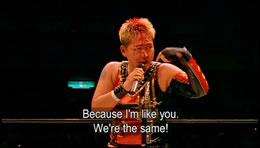 If you prefer your female societal outcasts with a bit more realism, definitely take a gander at the head-spinning double feature of Gaea Girls / Shinjuku Boys by Kim Longinotto and Jano Williams, available as a double-feature disc in the UK from the always excellent Second Run. The first feature is the more substantial of the two, clocking in at 99 minutes for a fascinating look at Japan's subculture of female wrestlers. While their society expects these girls to be a docile, feminine, and subservient, these women flip those conventions on their head by being as aggressive and violent as possible. Much of the footage is devoted to interviews and training at the gym, but the actual footage of their bouts is pretty astonishing (and sometimes bloody) as the women (including fan favorite Chigusa Nagayo) can even come off like estrogen-infused G.G. Allins in wrestling tights. On the other hand, the training process is incredibly grueling and even sadistic at times, with a couple of scenes that are almost impossible to watch without cringing. The anamorphic transfer is excellent with burned-in English subtitles for the dialogue sequences; you really won't believe what you're seeing. The co-feature runs a bit under an hour and comes from an obviously more dated video master (also with burned-in subs), but it's also worth seeing as it offers a completely different batch of "oddball" Japanese women. In this case, these "Shinjuku Boys" are crossdressing women passing themselves off as men known as onnabe at a nightclub catering to a female clientele. Many of them even use hormone injections and could be classified as transsexuals, a process covered in depth here through interviews and candid fly-on-the-wall footage. Director Longinotto (whose Divorce Iranian Style and Runaway marked a previous Second Run double feature) seems to be an expert in the many guises of womanhood around the world, and these two snapshots of real life gender benders is a real eye-opener. The disc also comes with a booklet of liner notes by critic Sophie Mayer and reflections on Jano Williams' cinematic output.
If you prefer your female societal outcasts with a bit more realism, definitely take a gander at the head-spinning double feature of Gaea Girls / Shinjuku Boys by Kim Longinotto and Jano Williams, available as a double-feature disc in the UK from the always excellent Second Run. The first feature is the more substantial of the two, clocking in at 99 minutes for a fascinating look at Japan's subculture of female wrestlers. While their society expects these girls to be a docile, feminine, and subservient, these women flip those conventions on their head by being as aggressive and violent as possible. Much of the footage is devoted to interviews and training at the gym, but the actual footage of their bouts is pretty astonishing (and sometimes bloody) as the women (including fan favorite Chigusa Nagayo) can even come off like estrogen-infused G.G. Allins in wrestling tights. On the other hand, the training process is incredibly grueling and even sadistic at times, with a couple of scenes that are almost impossible to watch without cringing. The anamorphic transfer is excellent with burned-in English subtitles for the dialogue sequences; you really won't believe what you're seeing. The co-feature runs a bit under an hour and comes from an obviously more dated video master (also with burned-in subs), but it's also worth seeing as it offers a completely different batch of "oddball" Japanese women. In this case, these "Shinjuku Boys" are crossdressing women passing themselves off as men known as onnabe at a nightclub catering to a female clientele. Many of them even use hormone injections and could be classified as transsexuals, a process covered in depth here through interviews and candid fly-on-the-wall footage. Director Longinotto (whose Divorce Iranian Style and Runaway marked a previous Second Run double feature) seems to be an expert in the many guises of womanhood around the world, and these two snapshots of real life gender benders is a real eye-opener. The disc also comes with a booklet of liner notes by critic Sophie Mayer and reflections on Jano Williams' cinematic output.
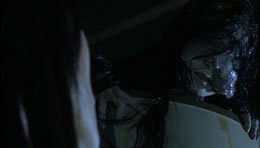 Of course, Japan is much better known internationally for its prolific horror output, and Cinema Epoch offers a typically gory 2009 sample with 2008's nasty, tech-oriented Hide and Go Kill. The setup here involves a blog that initiates a sort of cyber version of hide and seek, with the rapidly increasing number of schoolgirl fans sucked into a game in which you have to take a teddy bear, stuff it with rice and fingernail clippings at three in the afternoon, and stab it with a knife after submerging it in a bathtub. After that, each person has to chronicle the aftermath when a ghost shows up and starts playing hide and seek for real. Most of the film is spent with the girls yakking with each other online and then getting stalked one by one, with the ghost appearances forming the obvious highlights. Yeah, it's basically the umpteenth version of The Ring and The Grudge updated for the online era, but it packs in a few solid chills in the quick 71-minute running time thanks to that good old standby, the stringy-haired female ghost who can contort in a variety of disturbing positions. If that sounds good, you get a lot more of the same with the following year's Hide and Go Kill 2, which is almost a remake of the first film except with a concerned teacher thrown into the mix. More girls chat and post comments online, do the freaky routine with the teddy bear, and wind up spending a harrowing night playing hide and seek with a watery, nasty ghost that's probably going to leave them dead by morning. A very creepy scene late in the film in a boiler room involving two tag-teaming ghosts is a definite highlight here, and despite the sometimes murky digital photography, this is a worthy successor despite the overly inflated 100-minute running time. Both films are presented in anamorphic widescreen on separate DVDs with optional English subtitles and, apart from bonus Japanese horror trailers (Psycho Shark!), you don't get squat for extras.
Of course, Japan is much better known internationally for its prolific horror output, and Cinema Epoch offers a typically gory 2009 sample with 2008's nasty, tech-oriented Hide and Go Kill. The setup here involves a blog that initiates a sort of cyber version of hide and seek, with the rapidly increasing number of schoolgirl fans sucked into a game in which you have to take a teddy bear, stuff it with rice and fingernail clippings at three in the afternoon, and stab it with a knife after submerging it in a bathtub. After that, each person has to chronicle the aftermath when a ghost shows up and starts playing hide and seek for real. Most of the film is spent with the girls yakking with each other online and then getting stalked one by one, with the ghost appearances forming the obvious highlights. Yeah, it's basically the umpteenth version of The Ring and The Grudge updated for the online era, but it packs in a few solid chills in the quick 71-minute running time thanks to that good old standby, the stringy-haired female ghost who can contort in a variety of disturbing positions. If that sounds good, you get a lot more of the same with the following year's Hide and Go Kill 2, which is almost a remake of the first film except with a concerned teacher thrown into the mix. More girls chat and post comments online, do the freaky routine with the teddy bear, and wind up spending a harrowing night playing hide and seek with a watery, nasty ghost that's probably going to leave them dead by morning. A very creepy scene late in the film in a boiler room involving two tag-teaming ghosts is a definite highlight here, and despite the sometimes murky digital photography, this is a worthy successor despite the overly inflated 100-minute running time. Both films are presented in anamorphic widescreen on separate DVDs with optional English subtitles and, apart from bonus Japanese horror trailers (Psycho Shark!), you don't get squat for extras.
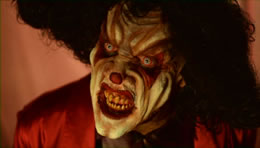 Killer clowns have been a reliable source of cinematic and literary terror and reached their arguable apex with Stephen King's It, but that hasn't stopped others from trying to top it ever since. Full Moon has even cranked an entire series out of the idea, kicking off with 2000's Killjoy. Incredibly, 2010 saw the release of Killjoy 3, which is obviously the third outing for the demonic killer clown with freaky pale eyes. Given that the first film was no great shakes and the sequel offered only a moderate step up, it's a surprising pleasure to report that this newest installment is actually the best of the bunch by a long shot. The story here is basically Hellraiser except with evil clowns as a professor dabbling in the occult summons Killjoy and his minions, only to slip away before they can close in on him. Enter four college students housesitting for the professor for the weekend, and in order to get a suitable body count to compensate for his frustration, Killjoy slips a mirror on their doorstep that turns into a portal to his demonic dimension where he hunts them down one by one. The most noteworthy additions here are sharp and colorful lighting designs courtesy of John Lechago and the presence of more villains including a mime clown, a hobo clown, and, uh, a clown with green hair and big boobs named Batty Boop. As far as Full Moon horror sequels go, you can file this with Subspecies II and the second Puppetmaster as overachievers who surpassed the originals. Extras include a new making-of featurette (which never quite explains why this had to be shot in China as it's all darkly lit interiors, but whatever), a vintage featurette from the set of the first film, and the expected avalanche of Full Moon promotional trailers.
Killer clowns have been a reliable source of cinematic and literary terror and reached their arguable apex with Stephen King's It, but that hasn't stopped others from trying to top it ever since. Full Moon has even cranked an entire series out of the idea, kicking off with 2000's Killjoy. Incredibly, 2010 saw the release of Killjoy 3, which is obviously the third outing for the demonic killer clown with freaky pale eyes. Given that the first film was no great shakes and the sequel offered only a moderate step up, it's a surprising pleasure to report that this newest installment is actually the best of the bunch by a long shot. The story here is basically Hellraiser except with evil clowns as a professor dabbling in the occult summons Killjoy and his minions, only to slip away before they can close in on him. Enter four college students housesitting for the professor for the weekend, and in order to get a suitable body count to compensate for his frustration, Killjoy slips a mirror on their doorstep that turns into a portal to his demonic dimension where he hunts them down one by one. The most noteworthy additions here are sharp and colorful lighting designs courtesy of John Lechago and the presence of more villains including a mime clown, a hobo clown, and, uh, a clown with green hair and big boobs named Batty Boop. As far as Full Moon horror sequels go, you can file this with Subspecies II and the second Puppetmaster as overachievers who surpassed the originals. Extras include a new making-of featurette (which never quite explains why this had to be shot in China as it's all darkly lit interiors, but whatever), a vintage featurette from the set of the first film, and the expected avalanche of Full Moon promotional trailers.
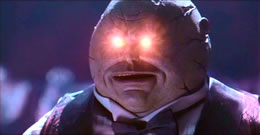 When Full Moon isn't busy doing sequels, they also find ways to recycle their original features to new audiences. Case in point: The Haunted Casino, a retitling of Charles Band's 2007 haunted casino oddity, Dead Man's Hand: Casino of the Damned. The big selling point here is the presence of horror cult favorites Sid Haig (Spider Baby) and Michael Berryman (The Hills Have Eyes) as a pair of dead Vegas mobsters haunting -- yep-- a decrepit old casino called Mysteria. The property's now passed into the hands of a guy named Matthew (Scott White) from his dead uncle, so he and some buddies decide to check it out and quickly realize they made a terrible, terrible mistake. A definite mixed bag, this one has a fairly lively climax and makes novel use of its setting, but the less than stunning performances by the young leads keep this from fulfilling its potential. On top of that, Haig and Berryman are almost entirely offstage until the third act, which means you have to put up with a lot of, erm, "character development" with people sitting around in dimly lit rooms. On top of that, the basic storyline was pretty hoary back in the '60s when it was called The Headless Ghost. The mediocre 4:3 letterbox video master from '07 gets recycled again here and really doesn't impress at all; it's hazy and murky throughout with mushy detail, and while it's commendable that Band went back to shooting on 35mm for this one, it really needs an upgrade to impress on any kind of visual level. Extras include a 12-minute making-of featurette (basically done in the usual Full Moon "Videozone" style with Band and the cast doing interviews and on-the-set guides through the film) and, yep, a lot more Full Moon trailers.
When Full Moon isn't busy doing sequels, they also find ways to recycle their original features to new audiences. Case in point: The Haunted Casino, a retitling of Charles Band's 2007 haunted casino oddity, Dead Man's Hand: Casino of the Damned. The big selling point here is the presence of horror cult favorites Sid Haig (Spider Baby) and Michael Berryman (The Hills Have Eyes) as a pair of dead Vegas mobsters haunting -- yep-- a decrepit old casino called Mysteria. The property's now passed into the hands of a guy named Matthew (Scott White) from his dead uncle, so he and some buddies decide to check it out and quickly realize they made a terrible, terrible mistake. A definite mixed bag, this one has a fairly lively climax and makes novel use of its setting, but the less than stunning performances by the young leads keep this from fulfilling its potential. On top of that, Haig and Berryman are almost entirely offstage until the third act, which means you have to put up with a lot of, erm, "character development" with people sitting around in dimly lit rooms. On top of that, the basic storyline was pretty hoary back in the '60s when it was called The Headless Ghost. The mediocre 4:3 letterbox video master from '07 gets recycled again here and really doesn't impress at all; it's hazy and murky throughout with mushy detail, and while it's commendable that Band went back to shooting on 35mm for this one, it really needs an upgrade to impress on any kind of visual level. Extras include a 12-minute making-of featurette (basically done in the usual Full Moon "Videozone" style with Band and the cast doing interviews and on-the-set guides through the film) and, yep, a lot more Full Moon trailers.
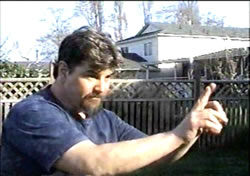 Hey, did you know that Bigfoot Is Real? Nope, me neither, but fans of the big hairy guy and his clawed cousins like the Abominable Snowman get a thorough study in this four-hour, double-disc release from Reality Films. The program is divided into sections like "Bigfooting in Oklahoma," "Tale of the Honey Island Swamp Monster," "Swamp Apes," and so on, with lots of talking heads and pixellated stock footage involving sightings of big hairy guys running around in the woods making strange noises. Disc two is actually The Wildman of Kentucky: The Myster of Panther Rock, which was covered here a few entries ago. Yep, it's still Bigfoot related, but if you already have that disc, be aware of what you're getting. Anyway, the first disc is basically a free-form study of three different scenarios involving everyone's favorite furry forest dweller, and the theories here can get pretty entertaining (especially when you hear about their family arrangements). I don't know whether any of this will change anyone's minds, but it's good for a slow evening when you feel like some '70s-style conspiracy theorizing with a lot of colorful characters.
Hey, did you know that Bigfoot Is Real? Nope, me neither, but fans of the big hairy guy and his clawed cousins like the Abominable Snowman get a thorough study in this four-hour, double-disc release from Reality Films. The program is divided into sections like "Bigfooting in Oklahoma," "Tale of the Honey Island Swamp Monster," "Swamp Apes," and so on, with lots of talking heads and pixellated stock footage involving sightings of big hairy guys running around in the woods making strange noises. Disc two is actually The Wildman of Kentucky: The Myster of Panther Rock, which was covered here a few entries ago. Yep, it's still Bigfoot related, but if you already have that disc, be aware of what you're getting. Anyway, the first disc is basically a free-form study of three different scenarios involving everyone's favorite furry forest dweller, and the theories here can get pretty entertaining (especially when you hear about their family arrangements). I don't know whether any of this will change anyone's minds, but it's good for a slow evening when you feel like some '70s-style conspiracy theorizing with a lot of colorful characters.
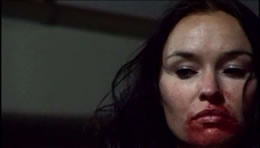 If the passing of poetic vampire auteur Jean Rollin still has you bummed, you might want to take a peek at the wildly pretentious Australian bloodsucker art film, A Nocturne: Night of the Vampire. Shot on the streets of Melbourne in 2007, it's about two vampires, X (Vanessa de Largie) and Z (Alex Spears), who live in a dingy warehouse and go out at night to forrage for food with two of their brethren. Mostly though they sit around among each other or with a poet and spout lots of half-baked philosophy about their relationship to humanity. Rollin certainly would've shot this with more visual style (it's all done on a standard def camcorder by all appearances), but at least the homage here is respectful and sometimes gets in the same ballpark. De Largie is definitely the most striking thing about the film, and while it never really goes much of anywhere, she proves she can carry a somber horror film on her shoulders. Troma's anamorphic disc can't work wonders given the very, very limited nature of the original source, especially given that some scenes are actually shot in fluorescent lighting (ugh), but they give it the good college try. Twenty minutes(!) of deleted yammering is also included if the 70 minutes here aren't quite enough, and you get a trailer and the usual batch of unrelated "Tromatic extras," too.
If the passing of poetic vampire auteur Jean Rollin still has you bummed, you might want to take a peek at the wildly pretentious Australian bloodsucker art film, A Nocturne: Night of the Vampire. Shot on the streets of Melbourne in 2007, it's about two vampires, X (Vanessa de Largie) and Z (Alex Spears), who live in a dingy warehouse and go out at night to forrage for food with two of their brethren. Mostly though they sit around among each other or with a poet and spout lots of half-baked philosophy about their relationship to humanity. Rollin certainly would've shot this with more visual style (it's all done on a standard def camcorder by all appearances), but at least the homage here is respectful and sometimes gets in the same ballpark. De Largie is definitely the most striking thing about the film, and while it never really goes much of anywhere, she proves she can carry a somber horror film on her shoulders. Troma's anamorphic disc can't work wonders given the very, very limited nature of the original source, especially given that some scenes are actually shot in fluorescent lighting (ugh), but they give it the good college try. Twenty minutes(!) of deleted yammering is also included if the 70 minutes here aren't quite enough, and you get a trailer and the usual batch of unrelated "Tromatic extras," too.
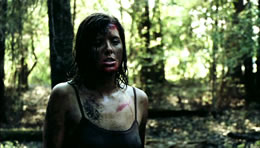 Sporting a title that dares viewers to start taking potshots before the credits start, 2009's Dismal actually derives its name from the swamp territory in which most of the action is set. A biology teaching assistant (Tim Morris) decides to drag five students out there for some extra credit, including obvious final girl Dana (Lydia Chandler) who needs it to get a passing grade. When a nearby family of deformed hillbillies catches wind that there's trespassers nearby, the smarty pants students are either killed outright or hauled back to the homestead for an evening of shocks and surprises. Yeah, it's all been done before (especially a twist yanked out of Leatherface: Texas Chainsaw Massacre III), but at least there's some blood, T&A, competent camerawork, and sort of a sick twist ending. The whole thing evaporates from your mind two minutes after it's over, but for an impulse rental on horror night when you're tired of the Wrong Turn movies, it'l pass the time. Cinema Epoch's anamorphic DVD looks good when you bear in mind that it was (surprise!) shot on DV, and apart from some unrelated trailers, that's all you get. At least there's a great bear trap gag, and that's enough to merit a look right there.
Sporting a title that dares viewers to start taking potshots before the credits start, 2009's Dismal actually derives its name from the swamp territory in which most of the action is set. A biology teaching assistant (Tim Morris) decides to drag five students out there for some extra credit, including obvious final girl Dana (Lydia Chandler) who needs it to get a passing grade. When a nearby family of deformed hillbillies catches wind that there's trespassers nearby, the smarty pants students are either killed outright or hauled back to the homestead for an evening of shocks and surprises. Yeah, it's all been done before (especially a twist yanked out of Leatherface: Texas Chainsaw Massacre III), but at least there's some blood, T&A, competent camerawork, and sort of a sick twist ending. The whole thing evaporates from your mind two minutes after it's over, but for an impulse rental on horror night when you're tired of the Wrong Turn movies, it'l pass the time. Cinema Epoch's anamorphic DVD looks good when you bear in mind that it was (surprise!) shot on DV, and apart from some unrelated trailers, that's all you get. At least there's a great bear trap gag, and that's enough to merit a look right there.
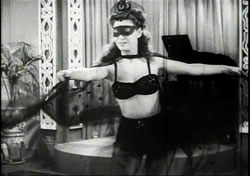
You'd think the folks at Secret Key had unearthed practically every cheesecake loop left in existence by now with their dozens of compilations, but they've managed to find another new wrinkle with American Nudie Classics, a sprawling collection of nudie-cutie short subjects from the '30s through the '60s. You get an average of slightly over half an hour for each of the four decades, with each providing an interesting snapshot of the era. The first decade block contains a heavy emphasis of naturism with silly shorts like "Sally's Sun Bath," "Nautical Nudes," "A Future Venus," and the surprisingly raunchy "Room Service, or Breakfast in Bed;" most of these involve cheerful women running around in their birthday suits near the ocean or a lake with dumpy guys around as the audience stand-in. The far less interesting '40s focuses more on burlesque-style performances with lots of pasties in evidence for titles like "Nancy from Frisco," "Sensational Sandra Storm," and
"Hipsy Dipsy." The arrival of color sparks things up a bit for the '50s, which also seems to feature the best-looking women of the set in fare like "Kalantan and Her Dance," "Miss Mystery," and "Wiggle Mad," climaxing with the weirdly beguiling and almost Kenneth Anger-ish "Ansco Girl." Finally things go much more explicit with the full-frontal '60s as women writhe around on various beds showing off their assets in "Maureen Smith," and "Harlem Honey." Print quality varies wildly from short to short, of course, but there's enough unique material here to keep vintage skin fans amused. Oddly, this one doesn't feature the company's usual liner notes or intros.
PREVIOUS SICK PICKS:
October 25, 2010
October 1, 2010
August 11, 2010
June 15, 2010
November 16, 2009
August 6, 2009
June 11 , 2009
March 19, 2009
October 27, 2008
August 7, 2008
July 25, 2008
May 31, 2008 (Aussie Special)
February 19, 2008
January 8, 2008
October 23, 2007
October 8, 2007
September 29, 2007
![]()